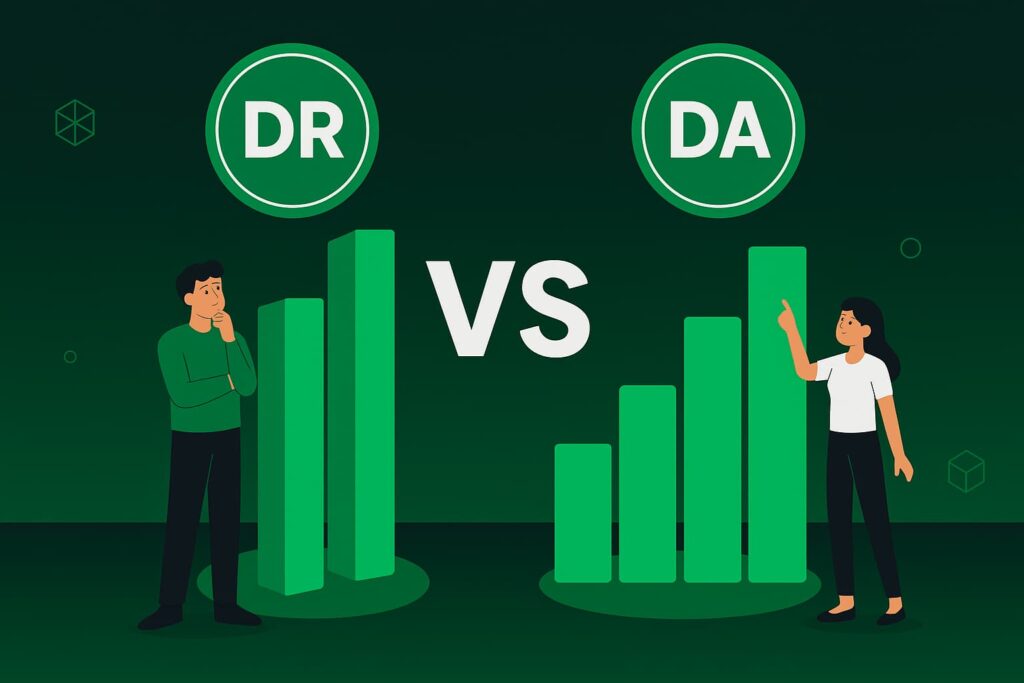When SEO practitioners and content marketers evaluate the “authority” of a website, two of the most frequently used metrics are Ahrefs’ Domain Rating (DR) and Moz’ Domain Authority (DA). Yet, many are still confused how does Ahrefs DR compare to DA.
Despite their superficial similarity (both are scored on roughly a 0-100 scale), they measure very different things – and using them interchangeably can lead to a flawed strategy.
In fact, one authoritative source found that the vast majority of pages (96.55 %) get no organic traffic from Google. This shows how even strong “authority” scores don’t guarantee ranking.
Read on as we break down what DR and DA really measure, how they differ, how reliable they are (and are not) predictors of ranking, and how you should use them in your SEO workflow.
Understanding Domain Authority (DA)
Domain Authority (DA) is a proprietary metric created by Moz. It assigns a score from 1 to 100 (on a logarithmic scale) that reflects how likely a domain is to rank in search engine results compared with other domains.
How does it work?
The Moz algorithm factors in multiple signals. This includes:
- Number of linking root domains
- Overall inbound links
- Domain size/age
- Machine-learning model trained on historical SERP rankings
Because the scale is logarithmic, increasing from DA 20 to DA 30 might be relatively achievable, but going from DA 70 to DA 80 is exponentially harder.
In practice, DA is often used for benchmarking: comparing your site against competitors in your niche, reporting to clients, or seeing how your site stacks up in terms of overall “authority”.
It’s important to note that DA is comparative. It doesn’t directly reflect traffic or keyword rankings, and it doesn’t guarantee performance. It’s one signal among many.
READ: Ahrefs vs Majestic vs Semrush vs Moz
Understanding Domain Rating (DR)
Domain Rating (DR) is the metric offered by Ahrefs, also ranging from 0 to 100. But DR is much more narrowly focused: it attempts to quantify the strength of the backlink profile of a domain (i.e., how many domains link to you, and how authoritative those linking domains are).
Ahrefs states that its crawler (AhrefsBot) visits over 8 billion webpages every 24 hours, giving it a large and up-to-date link index.
DR does not attempt to incorporate on-page factors, content relevance, domain age (beyond what’s implied by links), or other ranking signals outside of links. That narrow focus means DR is a pure link-equity metric — useful if link-building or backlink profiling is your main concern.
How Does Ahrefs DR Compare To DA
Here are some of the core ways DA and DR differ:
| Feature | DA (Moz) | DR (Ahrefs) |
| Primary Focus | Broad domain “ranking potential” | Backlink-profile strength |
| Signal Types Included | ~40+ factors (links + other domain signals) | Primarily referring domains & link quality |
| Scale/Logarithmic Nature | Yes — becoming harder at higher scores | Also harder at higher end, but more linear in growth |
| Update Frequency | Monthly-ish | More frequent (Ahrefs claims daily to recent) |
| Use Case | Overall domain benchmark, reporting | Link-building, backlink audits, competitor link profiling |
| Limitations | Doesn’t guarantee traffic or rankings; relative only | Doesn’t capture content, technical SEO, relevance, etc. |
Because of these differences: a site might have a high DR (many strong backlinks) yet a modest DA (if content, on-page optimization or other factors are weak); conversely, a site might have a decent DA but a lower DR (fewer high-quality links).
Interpreting these scores in isolation, or worse, comparing a DR 50 to a DA 50 as if they were equal can be misleading.
READ: Ahrefs vs Google Search Console Metrics
How Reliable Are They? The Reality Check
It’s critical to remember: neither DA nor DR is a direct ranking factor for Google. Both are third-party proxies. Industry research reveals that both DA and DR are surprisingly poor predictors of actual Google rankings, explaining only a small fraction of ranking variance.
What does this mean in practice? Use them as diagnostic tools, not as performance goals. They help you ask questions (e.g., “Why is my link profile weak compared to competitor X with higher DR?”), not as the answer (“I must get DR 80 to rank”).
When to Use DR vs. DA in Your SEO Strategy
Use DA when:
- You want a broad domain benchmark across competitors and industries.
- You’re reporting to non-SEO stakeholders and want to show “domain authority” in a simple way.
- You’re assessing overall site health (content + links + reputation) in aggregate.
Use DR when:
- You’re running a link-building campaign and need to identify backlink opportunities with strong linking domains.
- You’re auditing your backlink profile (referring domains, link strength, lost links) and want up-to-date link-index data.
- You’re gap-analysing competitors’ link profiles to find where you may be behind.
Recommended approach:
Pick one primary metric and track it consistently over time (e.g., your DR). But don’t ignore the other.
For example, you might benchmark DA monthly (since it updates less frequently) and use DR for more frequent link-profile monitoring. Meanwhile, always supplement with traffic metrics (organic traffic, keyword rankings), technical SEO health, content performance because authority scores alone won’t give you the full picture.
Practical Tips & Considerations
- Don’t chase scores. For example, suddenly acquiring many low-quality backlinks may raise DR temporarily, but if Google sees spammy links, you risk a penalty and no meaningful ranking gain.
- Context matters. A DR of 30 in a niche with low competition may be effective; in a highly competitive industry you may need DR 60+ and strong content.
- Focus on linking root domains, not raw links. Both metrics give more weight to unique referring domains than to sheer link count.
- Watch for score fluctuations. Because DR updates frequently, it can move day-to-day. Large drops often signal lost links or de-indexed referring domains.
- Use both metrics for opportunity filtering. For instance, when doing outreach, you might filter prospects by DR 50+, but also check their DA. If DA is low despite DR being high, that may mean the site has strong links but poor content/optimization (which may limit benefit to you).
- Remember other metrics. Domain authority/rating is only part of your story. Organic traffic, keyword rankings, engagement, crawl errors, mobile performance, and topical relevance all matter.
Conclusion
While both DA and DR aim to measure the “authority” of a domain, they do so in different ways and for different purposes. DR (by Ahrefs) is predominantly about the backlink profile which is a focused measure of link strength. DA (by Moz) is broader, attempting to capture overall ranking potential via multiple signals.
Neither is perfect, and neither should be treated as a magic number that guarantees success.
The best practice is to use them together within your SEO toolkit, understand what each one is actually telling you, and then act on gaps: build high-quality links (to raise DR), improve content and on-page optimization (to support DA).
Always benchmark, monitor trends, and align your efforts with real performance metrics, not just the number on the scale. After all, what truly matters is not your DR or DA, but whether your site is visible, ranking and driving traffic.
Frequently Asked Questions
What is Ahrefs Domain Rating (DR)?
Ahrefs Domain Rating (DR) is a metric developed by Ahrefs to measure the strength of a website’s backlink profile. It is scored on a 0–100 logarithmic scale, where higher scores indicate a stronger and more authoritative backlink profile.
DR is calculated primarily by analyzing:
- The number of unique referring domains linking to a site
- The quality and DR of those referring domains
- How link equity flows across the web
DR is not a Google ranking factor, but it is widely used to evaluate link-building prospects and overall backlink strength.
What is Moz Domain Authority (DA)?
Moz Domain Authority (DA) is a predictive metric created by Moz to estimate how likely a website is to rank on search engine results pages (SERPs). It also uses a 0–100 logarithmic scale, but its goal differs from DR: DA attempts to predict ranking performance rather than purely measure backlink strength.
DA is calculated using multiple factors, such as:
- Quality and quantity of backlinks
- Moz’s proprietary machine-learning models
- Link profile signals like spam score
- Overall domain strength indicators
Like DR, DA is not a Google ranking factor but is helpful for assessing a site’s competitive ranking potential.
Can I compare DA of one site with DR of another?
No, since they are calculated differently, a DA of 50 does not equate to a DR of 50. Always compare like with like (DA vs DA, DR vs DR).
Is a higher DR always better than a higher DA?
Not necessarily. A high DR shows a strong backlink profile, which is valuable, but if your content, relevance, technical SEO are weak, the boost in rankings may be limited. Meanwhile, a strong DA might indicate broader strength, but if your backlink profile is thin (low DR), you may struggle in competitive niches.
Are DA and DR ranking factors in Google’s algorithm?
No, neither metric is used by Google. They are third-party proxies created by Moz and Ahrefs respectively. Use them as tools, not as direct ranking signals.
How often should I check DR and DA?
For DR, you can monitor more frequently (weekly or bi-weekly) if you’re actively link-building. For DA, monthly or quarterly may suffice given its slower update cadence. Use trend-analysis rather than obsessing over daily fluctuations.




